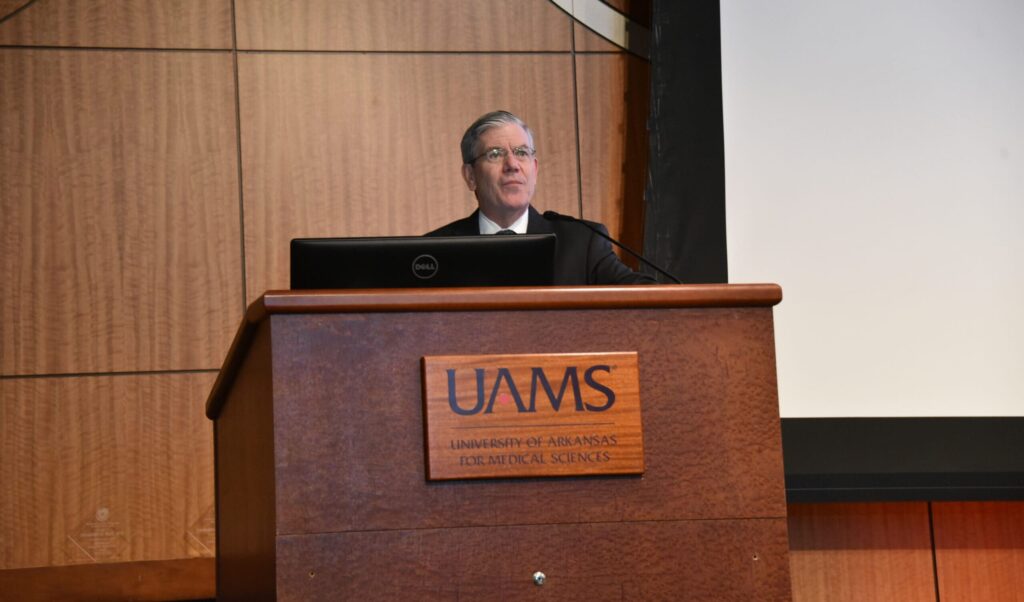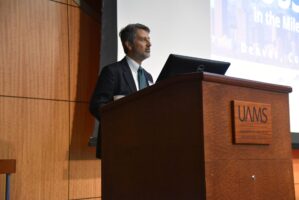By Chris Carmody
May 5, 2023 | The University of Arkansas for Medical Sciences (UAMS) hosted experts from the field of otolaryngology for a two-day conference that offered the latest in surgical techniques, clinical care and research.
The third annual Otolaryngology Diamond Conference extended its focus beyond the ear, nose and throat specialty by welcoming health professionals from a variety of treatment areas in the head and neck region.

“We wanted to cast a broader net by organizing this conference based on disease-specific areas,” said John Dornhoffer, M.D., chairman of the Department of Otolaryngology – Head and Neck Surgery in the UAMS College of Medicine.
The conference was divided into four sessions, each of which focused on a different specialty — otology, head and neck oncology, rhinology and pediatric otolaryngology. Each session featured a keynote speech by a guest lecturer, followed by a series of didactic presentations and a roundtable discussion involving experts from the field.

Fred Telischi, M.D., chairman of the Department of Otolaryngology – Head and Neck Surgery at the University of Miami’s Miller School of Medicine, kicked off the conference with a keynote speech about bone conduction devices. These devices transmit sound to the cochlea through vibrations in the bones of the skull, helping patients who have hearing loss linked to problems in the outer and middle ear.
About 200,000 bone conduction devices have been implanted in patients around the world, Telischi said. This makes it a less prevalent treatment than cochlear implants — with more than 1 million implanted worldwide — or hearing aids, which are used by millions of people each year.
Telischi noted that many of the problems addressed by bone conduction devices — such as aural atresia, a condition in which the ear canal fails to develop properly — affect a smaller number of patients, which limits the reach of this technology.
“Bone conduction devices have their niche within the compendium of acoustic devices and implants that we have for the treatment of hearing loss, and I think they’re still important,” he said.
Bone conduction techniques date to the 1500s, Telischi said. In the 19th century, Ludwig van Beethoven famously used bone conduction to continue composing music despite his hearing loss, taking in the sounds of his piano by clenching his teeth on a rod that he connected to the instrument.
Telischi said the modern era of bone conduction technology began with Jack Hough, an otologist known for developing microsurgical procedures to restore patients’ hearing. In 1985, Hough created a transcutaneous device for bone conduction. More recent developments in osseointegration, the connection between the implant and bone, have given rise to the transcutaneous and percutaneous products on the market today.
Looking to the future, Telischi predicted that the technology will continue to improve as new devices are developed.
“I think bone conduction devices are here to stay, as there will be continued demand for them in cases of conductive and mixed hearing loss,” he said.
Other presentations during the otology session focused on accessibility of hearing-health treatments, which Dornhoffer described as a significant problem both in the United States and throughout the world.

The first day of the conference concluded with a session devoted to head and neck oncology. Umamaheswar Duvvuri, M.D., Ph.D., associate professor in the Department of Otolaryngology at the University of Pittsburgh School of Medicine, gave a keynote speech on state-of-the-art treatments for oropharyngeal cancer.
Stella E. Lee, M.D., a faculty member in the Department of Otolaryngology – Head and Neck Surgery at Harvard Medical School and director of the Brigham Sinus Center at Brigham and Women’s Hospital in Boston, began the second day’s sessions with a rhinology lecture that focused on shifting paradigms in treatment. In the afternoon session, Ron B. Mitchell, M.D., professor of Otolaryngology, Head and Neck Surgery and chief of pediatric otolaryngology at the University of Texas Southwestern Medical Center in Dallas, gave a lecture on trends in pediatric obstructive sleep apnea.
Dornhoffer said each of the four sessions fostered discussion about important issues that medical professionals face today.
“The multidisciplinary format allowed us to highlight a number of interesting topics in these specialty areas,” he said. “I’m grateful for all the guest professors and participants who helped make this conference a success.”
